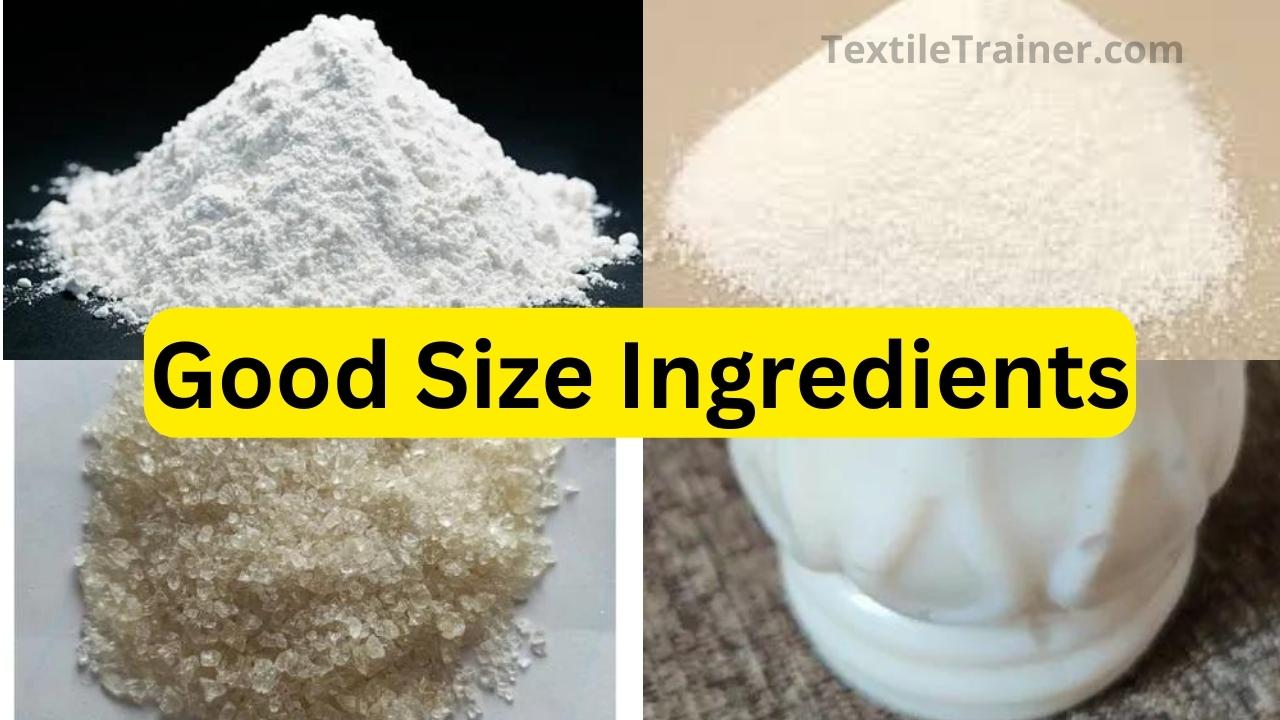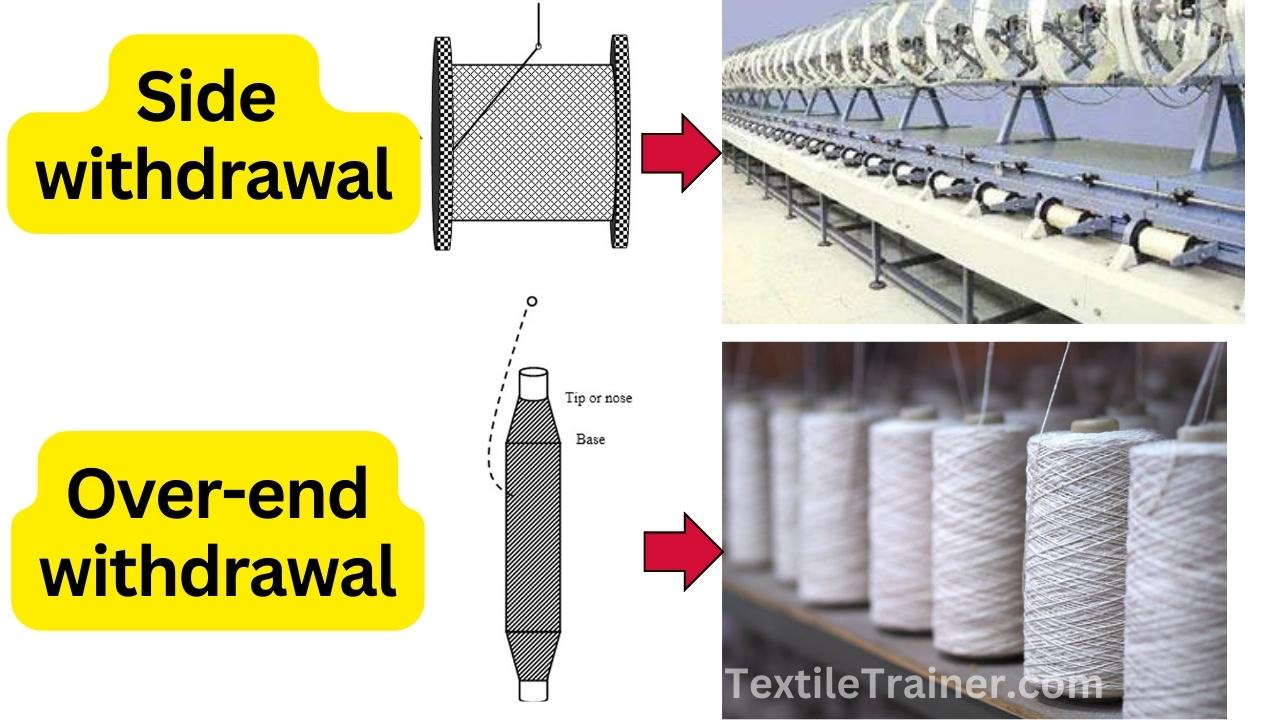Primary and Secondary Sizing Ingredients with Effective Function
What is Sizing Ingredients?
The ingredients used to prepare the sizing liquor for the sizing process are called sizing ingredients. The most basic objectives of the sizing can be accomplished only by impregnating the yarn with the appropriate size mixture consisting of different sizing ingredients in the correct proportions in order to achieve the objective of sizing.
Consequently, there are two types of ingredients, the primary and secondary ones, which will impart a particular property to the yarn. Primary ingredients are those that are essentially required in the size paste, while secondary ingredients are those that can be added to the size mixture depending on the requirements, but are not necessarily required. Essentially, the primary ingredient is the main size ingredient, which helps to add strength to the warp yarn as well as make it more resistant to abrasion. Secondary ingredients, which are added to the yarn by using other ingredients, add to its feel, weight, appearance, etc. They are called secondary ingredients.

Types of Sizing Ingredients:
There are tow types of size ingredients used in weaving section sizing preparation.
- Primary sizing Ingredients
- Adhesives
- Softeners/Lubricating agent
- Antiseptics
- Secondary Sizing Ingredients.
- Hygroscopic agent/Humectants
- Weighting agents.
- Tinting agent/Brightening/Bluing agent
- Wetting agents.
- Antifoaming agents.
- Antistatic
1. Primary Sizing Ingredients:
The primary ingredients in the size paste refer to the essential components that are crucially needed in order to create the sizing solution that will be used in the sizing process for warp yarns in weaving. Size paste’s main ingredient is the primary ingredient that plays a crucial role in enhancing the yarn’s properties. It consists of a number of essential ingredients such as: Adhesives, softeners or lubricating agent, antiseptics which is brief described below.
Adhesives:
Adhesives are materials that can adhere to the warp yarns throughout the weaving process by increasing the yarn strength and making its surface smooth to withstand abrasion between neighboring warp threads. By binding the yarn fibers together, adhesives make the yarn stronger to withstand weaving stresses and strains. Fibers are bonded together by adhesives, which enhance cohesion. Additionally, the adhesive should have a certain level of viscosity to form a thin uniform film around the yarn surface, reducing frictional resistance, reducing abrasion between neighboring warp threads. The adhesive should bind protruding fibers to the yarn surface as well.
There are several types of adhesives available, and they are listed below:
- Starch and starch products: maize starch, tapioca starch, potato starch, sago starch, wheat starch, etc.
- A thin boiling starch or soluble starch: British gum or dextrin
- Natural adhesives: Tamarind Kernel powder, gum Arabic, gum tragacanth, gum Karaya, beam gums.
- Protein substances: glucosamine, gelatin, casein, soy protein, etc.
- Pectin materials: alginic acid
- Derivatives of starch, gum, and cellulose: starch ethers and esters, gum guar, and carboxymethyl cellulose.
- Synthetic adhesives: polyvinyl alcohol, acrylic polymers, vinyl polymers, polyethylene glycol, and polystyrene.
Function:
- Enhance warp yarn strength, making them more resistant to breaking during weaving.
- Improve warp yarn smoothness for neater, more uniform threads.
- Increase the elasticity of the yarns for controlled extension during weaving.
- Increasing the stiffness of the yarns will improve weaving control and alignment.
- Minimize excessive stretch by reducing yarn extension percentages.
Softeners/ Lubricating agents:
The adhesives produce a film on the yarn, which is rather stiff and renders the yarn inflexible. It is therefore necessary to add softener to the adhesive film to make it flexible or pliable. A softening agent or lubricating agent gives fabrics a soft feel and a smooth appearance.
Example: oils, fats, waxes, mutton tallow, oils and emulsions, stearic acid emulsions, vegetable tallow, soaps, mineral oils, paraffin waxes, plasticizers, and other substances. As a softener and lubricant, mutton tallow is one of the best softeners available.
Function:
- Make the yarn soft and slippery to improve its overall feel and allow for smoother weaving.
- Improve uniformity in woven fabrics by smoothing yarn’s surface.
- Reduce the stiffness of the yarn, making it more malleable and easier to weave.
- Maintain proper tension and alignment by decreasing yarn flexibility.
- Reduce friction between the yarns, allowing them to move more smoothly through the loom.
Antiseptic:
In order to prevent mildew formation or bacteria from growing in sized beams or fabric woven from sized warps, antiseptics or anti mildew agents are used. It is important to add some antiseptic agent to the sizing liquor to prevent bacteria or mildew from forming in humid conditions or rainy seasons. A sizing liquor that contains some antiseptic agents is used to prevent this issue.
Example:
- Chemical compounds: Salicylic acid, phenol, cresol, benzoic acid, etc.
- Metallic salts: Zinc chloride, copper sulphate, zinc sulphate, sodium silicofluoride.
- Zinc chloride is the most effective antiseptic since it is both antiseptic and humectant.
Function:
- This prevents the formation of mildew on the sized material.
- Makes the size paste last longer.
- Ensures long-term storage of the sized yarn.
- Prevents bacterial or fungal growth on the size material.
- Prevents contamination or degradation of the size material.
2. Secondary Sizing Ingredients:
Depending on the size mixture requirements, secondary ingredients may or may not be added. Secondary ingredients are those that add to the feel, weight, appearance, etc. of yarn. Some essential secondary sizing ingredients are described below:
Hygroscopic agent/Humectants:
Hygroscopic agents are agents used to hydrate yarn and prevent it from drying too much. They help sized yarns regain their flexibility and moisture. As a result, the deliquescent keeps cotton yarn from drying out and becoming brittle by retaining moisture at the required level of 8-10%, thus keeping the yarn flexible at all times. Nowadays, moisture controllers are used in sizing machines instead of these, so they are not required.
Example: Zinc Chloride (ZnCl2), Magnesium Chloride (MgCl2), Glycerin, etc.
Function:
Maintains optimal moisture levels in the yarn by moisturizing it.
- Assists in preventing excessive yarn drying during sizing.
- Controls the moisture content of the yarn and ensures it is consistent.
Weighting Agents:
There are other names for these agents as well, such as weighting agents, filling agents, fillers, etc. Weighting agents add weight to yarn in order to give the fabric a fuller feel. They are used to increase the weight of yarn and impart a fullness and feel to the fabric.
Example: China clay, Gypsum, Talc or French chalk or soapstone, Barium sulphate, Epsom salt etc.
Function:
- Increases fabric density and substance by increasing yarn weight.
- Adding fullness to the fabric increases volume and body, making it feel luxurious and substantial.
- Softens and drapes the fabric, creating a comfortable and pleasing feel.
- Prevents excessive opening and spreading of the fabric during handling.
Tinting Agents:
A tinting agent is a substance that is used for the temporary coloring of textile materials by adding color to them for a short period of time.
Example: optical brightener, tinapol, Ultramarine blue.
Function:
- Enhances the brightness and luster of the yarn.
- It removes yellowish tints from yarn, making it whiter.
- Ensures clean and free of loose particles yarn by preventing dusting off.
- It helps to achieve a specific shade or color for the yarn, allowing for color customization.
Wetting Agents:
Synthetic textiles, such as polyester, nylon, etc., cannot be wet by natural adhesives such as starch, since they are hydrophobic. Synthetic adhesives must therefore be applied in conjunction with a suitable wetting medium. Wetting agents are used to distribute the sizing solution uniformly.
Example: Sulphanol, Soap, MgCl2
Function:
- Increases size exhaust, reducing waste and maximizing efficiency.
- Increases consistency and uniformity of coating throughout the yarn by ensuring even distribution of the sizing solution.
Antifoaming Agents:
During the sizing, there is always the possibility of foam generation in the sow box’s size. A foam is produced by surface-active agents present in size paste. A churning action of the rollers produces alkali foam. The foam that is carried by the warp sheets causes smudging of the drying cylinders. To reduce the foaming tendency of the size paste, anti-foaming agents should be added. Ultimately, we can say that an antifoaming agent is one that prevents foam from forming.
Example: amyl alcohol, turpentine, pine oil etc.
Function:
- Reduces bubbles or froth in size paste by preventing foam formation during sizing.
- Ensures smooth and consistent application of size paste in yarn without disruptions from foam.
Antistatic Agents:
A number of antistatic agents are considered secondary ingredients; however they are vital in sizing synthetic hydrophobics prone to static electricity. Static electricity is very common in fibers like polyester, nylon, and cellulose acetate. It is difficult for the weaver to unwind the weaver’s beams or cloth rolls when static charges are generated. In extreme cases, they can even pose a fire hazard. Therefore, static charge generation must be controlled.
Example: glycerol, polyethylene glycol, lissapol NX. Out of these, Lissapol NX is the best. Besides, several antistatic agents may be anionic, cationic, and non-ionic or amphoteric in nature.
Function:
- During sizing, these agent reduce static charge generation.
- Controlling static charges prevents problems after unwinding weaver’s beams or cloth rolls.
- Fire hazards can be avoided by static charge control.
Conclusion:
As part of sizing, primary and secondary ingredients work together to enhance the warp yarn’s strength, smoothness, flexibility, and quality. Among the primary ingredients are starch and water, which provide adhesive properties and hydration, while secondary ingredients include emulsifiers and defoamers that aid in the sizing process. The combination of antibacterial and antistatic agents ensures the protection of woven fabrics from microbial growth, and promotes safety and efficiency through the control of static charges. If you have any questions about this article, please feel free to ask me in the comment section below. Please support me by sharing my article with your friends on your social channels.
You may read:



